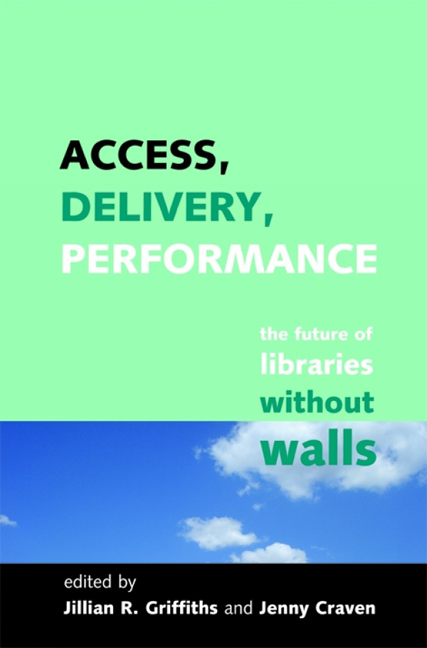Book contents
- Frontmatter
- Contents
- Contributors
- 1 Introduction
- 2 The Library Research Unit at the University of Lancaster, 1967–1972: a memoir
- Theme 1 Libraries, learning and distance learning
- 3 Alice in www.land: reflections on ten years of developing library services for distance learners
- 4 Putting the ‘e’ into libraries and learning: study, pedagogy, content and services in the digital age
- Theme 2 Widening access to information
- Theme 3 Changing directions of information delivery
- Theme 4 Performance, quality and leadership
- Peter Brophy: a selected bibliography
- Index
4 - Putting the ‘e’ into libraries and learning: study, pedagogy, content and services in the digital age
from Theme 1 - Libraries, learning and distance learning
Published online by Cambridge University Press: 08 June 2018
- Frontmatter
- Contents
- Contributors
- 1 Introduction
- 2 The Library Research Unit at the University of Lancaster, 1967–1972: a memoir
- Theme 1 Libraries, learning and distance learning
- 3 Alice in www.land: reflections on ten years of developing library services for distance learners
- 4 Putting the ‘e’ into libraries and learning: study, pedagogy, content and services in the digital age
- Theme 2 Widening access to information
- Theme 3 Changing directions of information delivery
- Theme 4 Performance, quality and leadership
- Peter Brophy: a selected bibliography
- Index
Summary
Introduction
This chapter focuses on the history, development, application and future of information and communications technology (ICT) in the field of learning and teaching with special reference to UK higher education (UKHE). The work of the Joint Information Systems Committee (JISC) in improving the take-up of ICT is highlighted.
Background
Just over ten years ago, a report was produced by the Higher Education Funding Council for England (HEFCE, 1997) that looked at the reasons behind the low take-up of ICT in learning and teaching activities within UK HE. Although technology was already pervasive in higher education institutions (HEIs), its usage at that time had been primarily for administrative or ‘housekeeping’ activities rather than the delivery of teaching or the support of learning. This was despite the fact that there had been a significant investment in the development of ICTbased teaching and learning aids (courseware, computer-assisted or computerbased learning packages, websites, portals and gateways, virtual and managed learning environments – V/MLEs) notably through a series of national initiatives within the higher education (HE) community, and primarily – at the time – the Computers in Teaching Initiative (CTI), the Teaching and Learning Technology Programme (TLTP) and a whole series of projects commissioned and funded by the JISC. The Dearing Report on the future of higher education published that same year (National Committee of Enquiry into Higher Education, 1997) stressed the significant knowledge gap in HEIs with regard to ICT, including at the most senior levels, where a ‘deep understanding’ of the key issues seemed to be sadly lacking.
In the 1990s, ICT applications were seen as a way of gaining productivity and maintaining quality at a time when there were fewer members of teaching staff because of economic cutback, though the Summative Evaluation of Phase 3 of the eLib Initiative (Whitelaw and Joy, 2001) subsequently concluded that there had been no real cost savings as a result of the Follett Report (Joint Funding Councils’ Libraries Review Group, 1993); rather there had been both an increased functionality and an increasing empowerment of the user, at least in terms of learning and teaching. Follett also recognized that it was important not to graft new technologies onto old (as has happened in previous ICT-based learning and teaching programmes and projects to some degree) but to look afresh at the issues and the appropriate applications as a whole.
Information
- Type
- Chapter
- Information
- Access, Delivery, PerformanceThe Future of Libraries Without Walls, pp. 39 - 54Publisher: FacetPrint publication year: 2008
Accessibility standard: Unknown
Why this information is here
This section outlines the accessibility features of this content - including support for screen readers, full keyboard navigation and high-contrast display options. This may not be relevant for you.Accessibility Information
- 1
- Cited by
